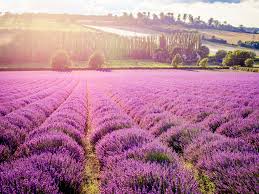Lavender can take much of the credit for the revival and interest in aromatherapy today. At different stages in history lavender has been valued for its impressive healing powers and it is these healing properties that make it one of the most important essential oils.

Not only is it a natural antibiotic, antiseptic, anti-depressant, sedative and detoxifier, it is also able to promote healing and prevent scarring.
Most essential oils need diluting in carrier oil before use, but lavender is exceptional because it's so gentle you can use it neat in some instances. A drop on the cushion pad of a plaster, for example, can speed up the healing process and can protect the skin from infection. A drop on your pillow, or a few drops in a bath, at night-time can aid sleep and, if you get nervous or anxious, you can put a drop on a cotton wool pad and sniff it through the day to calm frazzled nerves.
By itself lavender's distinctive but light, floral aroma has a calming effect on the mind and the oil is helpful for its ability to bring both mind and body back into a state of balance, so that healing can take place.
Used in a massage blend or in the bath, lavender is also good for muscular pain, whether caused by tension, exercise or rheumatism. Massaged gently into the lower abdomen, lavender will also help relieve menstrual pain.
Lavender's gentle nature makes it ideal for children and babies too. Lavender is useful for childhood infections as well as helpful for soothing temper tantrums and upsets.
From Flower to Oil
Aromatherapy usually uses common lavender (known as Lavendula augustifolia, Lavendula officinalis or Lavandula vera). Common lavender shouldn't be confused with lavendin or spike lavender, both of which have different effects on the body and mind. Although rarely available, avoid essential oils made from Lavendula stoechas, as this doesn't have the same properties as common lavender and isn't suitable for home use.

The south of France is still the main producer of lavender. For many years lavender was gathered from hillsides by shepherds and local people who sold it to the perfumers of Grasse. In the 1950s, however, with demand for the oil increasing, fields containing neat rows of bushes were introduced.
So great is the call for lavender in recent years that it is now grown in places such as China and Tasmania. England also has a history of lavender growing.
To turn the bright purple flowers into essential oil, the stems are laid on a grid and steam is passed through them. The plant essence from the flowers is released in the form of vapour, which is cooled in tanks to make essential oil.
Tested by Time
Through the ages lavender has been recommended for just about every complaint known to mankind. It was even used by the ancient Greeks, for throat infections, constipation and chest complaints.
The Romans put lavender flower heads in the communal baths, probably as much as an antiseptic as for their fragrance. Many medieval European herbalists advised on the use of lavender water to prevent head lice, and for centuries lavender flowers have been tied into small bundles and placed in laundry to make it smell fresh and keep the moths away. Bundles of lavender were also placed in pillows to make them smell sweet and to deter bed bugs.
At the beginning of the 20th century, the significance of lavender's natural healing properties moved aromatherapy into a new era. Chemist René Maurice Gattefossé was working in his father's perfume and cosmetic factory when there was a small explosion and Gattefossé's hand was burnt. He immersed it in neat lavender oil and to his astonishment, his hand quickly healed and showed no sign of infection or scarring.
Intrigued by his own experience Gattefossé decided to collate all the available research on the medicinal qualities of different essential oils and carried out further research himself. Eventually in 1937, he published the book, Aromathérapie, so giving us the word 'aromatherapy'.